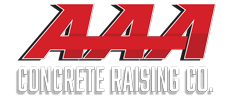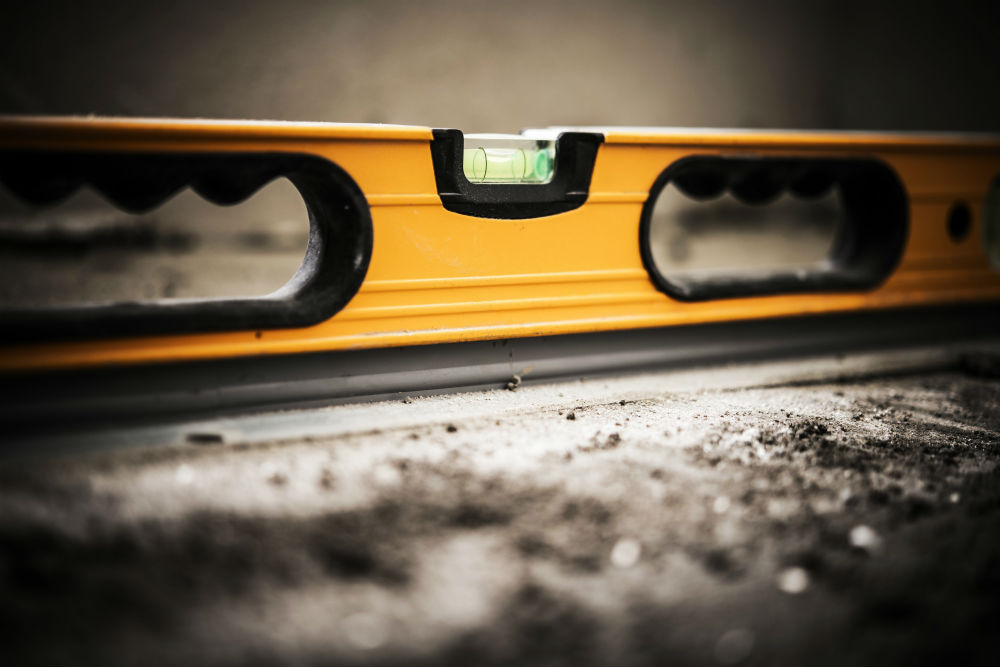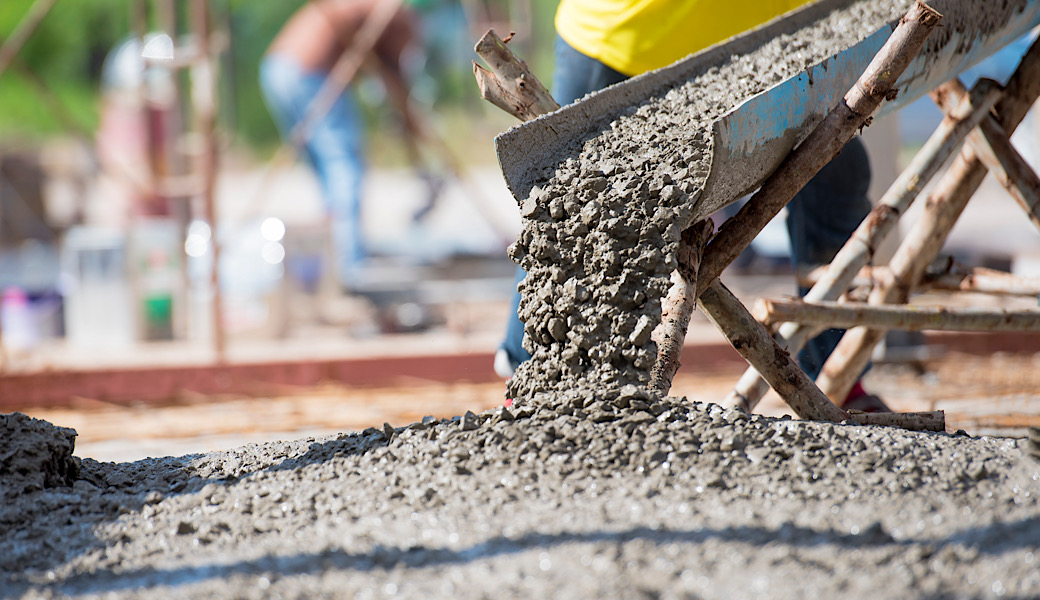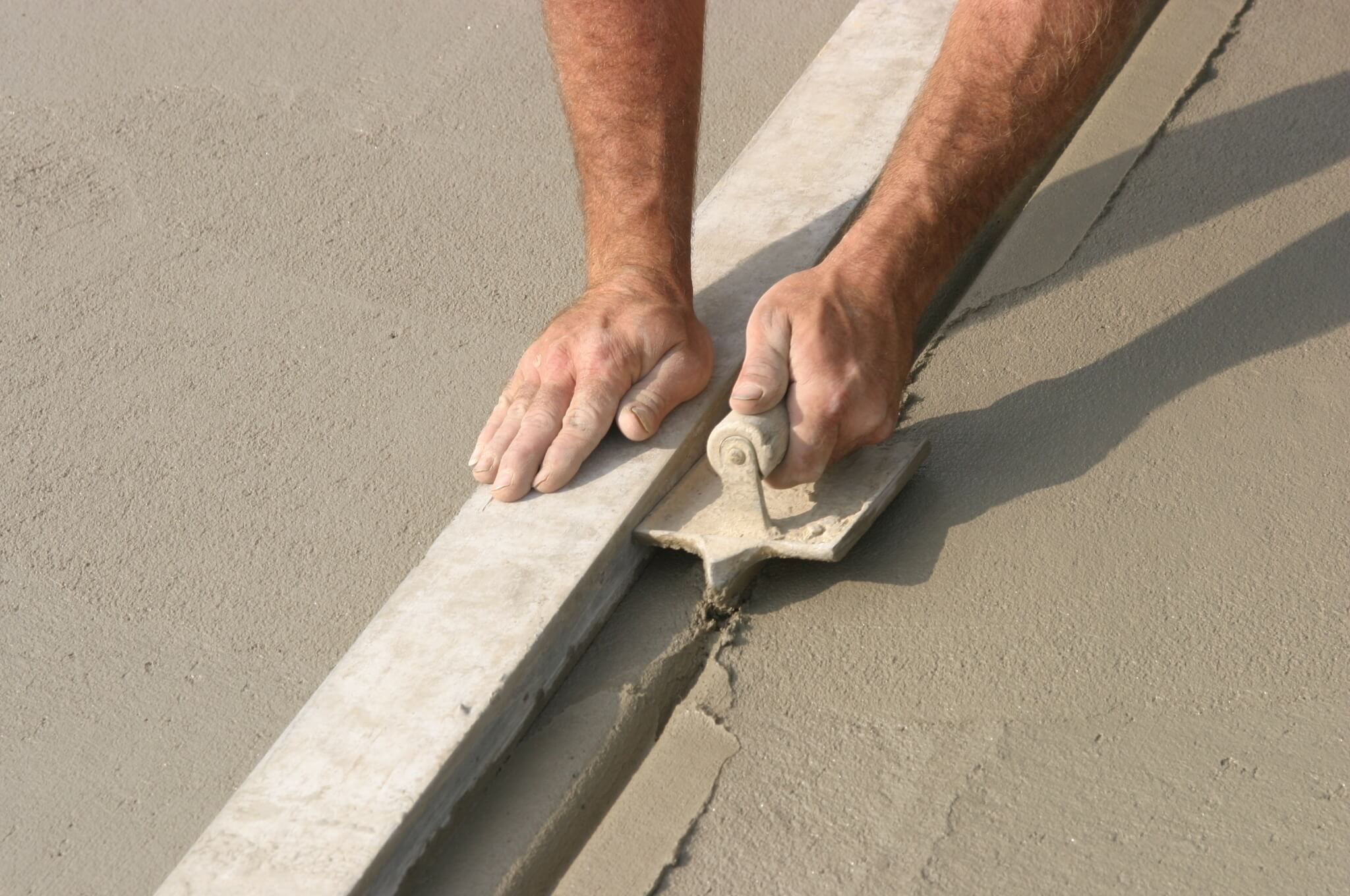Regardless how old concrete is, how well it’s supported, and how it has been maintained over the years, it’s an inevitability: concrete is going to eventually start to sag, crack, and warp.
This can be frustrating for home and business owners. It’s common to suddenly notice a concrete leveling problem even though it’s probably been developing over a period of many years.
It’s no surprise that sloping or sagging concrete lists as one of the most expensive issues to fix, because the equipment, raw materials, and labor required to do so is extensive. If you’ve decided that it’s time to fix a section of unlevel concrete, you might be confused about how best to go about it.
AAA Concrete Raising is an established concrete rehabilitation service provider that has been resolving even the most challenging concrete leveling situations since 1988. In our 30+ years of being in business, we’ve heard a lot of misinformation when it comes to the most effective and sustainable techniques used to level concrete.
In this blog post, we’re going to look at two of the most common approaches to raising concrete: mudjacking and poly foam injection. Our goal is to educate you on what makes each of these techniques more advantageous than the other, providing examples along the way.
Why Concrete Sags in the First Place
To better understand the pros and cons of mudjacking versus poly foam injection, it might help to explain why concrete that was once level starts to unsettle.
Virtually all concrete installations rely on subsurface support in order to maintain a smooth, level concrete face. The amount of support that is in place at the time of concrete pouring varies widely from site to site, and it’s rare that any two are the same.
Also, there’s only so much that can be done to prepare the ground for concrete. Impaction, loose ground removal, and other methods of pretreatment do help, but there’s rarely ever any guarantee that the subsurface won’t shift over time.
Remember that here in Colorado, our climate is constantly changing, week-in and week-out. We experience some of the most radical shifts in temperatures, humidity, and air pressure, and these changes cause rapid expansion and contraction of not just concrete, but the support structure below it.
Given enough time, voids will begin to develop below the concrete. As the seasons come and go, snow falls and melts, temperatures change…these voids grow in size. Then, before you know it, there are voids large enough to cause the concrete above them to unsettle.
The Poly Foam Solution
Now that you know why concrete becomes unleveled, let’s examine the benefits of using poly foam injection to correct the problem.
Using this technique, holes are drilled into the affected concrete. Then, a specially formulated foam substance is injected into the voids beneath the concrete. As this happens, the poly foam expands a determined amount, filling the voids as much as possible.
While this technique might be a ‘quick fix’ to level the concrete, it almost always comes up short in filling all of the voids below the concrete, as the foam only expands to a set threshold.
What’s more, not all poly foam formulations are safe for the environment or for the laborers who have to work with it. There are applications in which poly foam concrete raising is a smart choice, but it almost always leaves unfilled voids that will have to be addressed later on down the line.
The Mudjacking Solution
The term ‘mudjacking’ refers to the use of a gravel slurry—often composed of emulsified, rocky material and water—to fill the voids below the unlevel concrete.
The mudjacking approach to leveling concrete is similar to poly foam injecting, however the entire process is safer both for the environment and the laborers. Moreover, the gravel slurry used in mudjacking does a better job of infiltrating all of the voids below the uneven concrete, and there is no ‘expansion limit’ like there is with poly foam.
Regardless how old concrete is, how well it’s supported, and how it has been maintained over the years, it’s an inevitability: concrete is going to eventually start to sag, crack, and warp.
This can be frustrating for home and business owners. It’s common to suddenly notice a concrete leveling problem even though it’s probably been developing over a period of many years.
It’s no surprise that sloping or sagging concrete lists as one of the most expensive issues to fix, because the equipment, raw materials, and labor required to do so is extensive. If you’ve decided that it’s time to fix a section of unlevel concrete, you might be confused about how best to go about it.
AAA Concrete Raising is an established concrete rehabilitation service provider that has been resolving even the most challenging concrete leveling situations since 1988. In our 30+ years of being in business, we’ve heard a lot of misinformation when it comes to the most effective and sustainable techniques used to level concrete.
In this blog post, we’re going to look at two of the most common approaches to raising concrete: mudjacking and poly foam injection. Our goal is to educate you on what makes each of these techniques more advantageous than the other, providing examples along the way.
Why Concrete Sags in the First Place
To better understand the pros and cons of mudjacking versus poly foam injection, it might help to explain why concrete that was once level starts to unsettle.
Virtually all concrete installations rely on subsurface support in order to maintain a smooth, level concrete face. The amount of support that is in place at the time of concrete pouring varies widely from site to site, and it’s rare that any two are the same.
Also, there’s only so much that can be done to prepare the ground for concrete. Impaction, loose ground removal, and other methods of pretreatment do help, but there’s rarely ever any guarantee that the subsurface won’t shift over time.
Remember that here in Colorado, our climate is constantly changing, week-in and week-out. We experience some of the most radical shifts in temperatures, humidity, and air pressure, and these changes cause rapid expansion and contraction of not just concrete, but the support structure below it.
Given enough time, voids will begin to develop below the concrete. As the seasons come and go, snow falls and melts, temperatures change…these voids grow in size. Then, before you know it, there are voids large enough to cause the concrete above them to unsettle.
The Poly Foam Solution
Now that you know why concrete becomes unleveled, let’s examine the benefits of using poly foam injection to correct the problem.
Using this technique, holes are drilled into the affected concrete. Then, a specially formulated foam substance is injected into the voids beneath the concrete. As this happens, the poly foam expands a determined amount, filling the voids as much as possible.
While this technique might be a ‘quick fix’ to level the concrete, it almost always comes up short in filling all of the voids below the concrete, as the foam only expands to a set threshold.
What’s more, not all poly foam formulations are safe for the environment or for the laborers who have to work with it. There are applications in which poly foam concrete raising is a smart choice, but it almost always leaves unfilled voids that will have to be addressed later on down the line.
The Mudjacking Solution
The term ‘mudjacking’ refers to the use of a gravel slurry—often composed of emulsified, rocky material and water—to fill the voids below the unlevel concrete.
The mudjacking approach to leveling concrete is similar to poly foam injecting, however the entire process is safer both for the environment and the laborers. Moreover, the gravel slurry used in mudjacking does a better job of infiltrating all of the voids below the uneven concrete, and there is no ‘expansion limit’ like there is with poly foam.
Regardless how old concrete is, how well it’s supported, and how it has been maintained over the years, it’s an inevitability: concrete is going to eventually start to sag, crack, and warp.
This can be frustrating for home and business owners. It’s common to suddenly notice a concrete leveling problem even though it’s probably been developing over a period of many years.
It’s no surprise that sloping or sagging concrete lists as one of the most expensive issues to fix, because the equipment, raw materials, and labor required to do so is extensive. If you’ve decided that it’s time to fix a section of unlevel concrete, you might be confused about how best to go about it.
AAA Concrete Raising is an established concrete rehabilitation service provider that has been resolving even the most challenging concrete leveling situations since 1988. In our 30+ years of being in business, we’ve heard a lot of misinformation when it comes to the most effective and sustainable techniques used to level concrete.
In this blog post, we’re going to look at two of the most common approaches to raising concrete: mudjacking and poly foam injection. Our goal is to educate you on what makes each of these techniques more advantageous than the other, providing examples along the way.
Why Concrete Sags in the First Place
To better understand the pros and cons of mudjacking versus poly foam injection, it might help to explain why concrete that was once level starts to unsettle.
Virtually all concrete installations rely on subsurface support in order to maintain a smooth, level concrete face. The amount of support that is in place at the time of concrete pouring varies widely from site to site, and it’s rare that any two are the same.
Also, there’s only so much that can be done to prepare the ground for concrete. Impaction, loose ground removal, and other methods of pretreatment do help, but there’s rarely ever any guarantee that the subsurface won’t shift over time.
Remember that here in Colorado, our climate is constantly changing, week-in and week-out. We experience some of the most radical shifts in temperatures, humidity, and air pressure, and these changes cause rapid expansion and contraction of not just concrete, but the support structure below it.
Given enough time, voids will begin to develop below the concrete. As the seasons come and go, snow falls and melts, temperatures change…these voids grow in size. Then, before you know it, there are voids large enough to cause the concrete above them to unsettle.
The Poly Foam Solution
Now that you know why concrete becomes unleveled, let’s examine the benefits of using poly foam injection to correct the problem.
Using this technique, holes are drilled into the affected concrete. Then, a specially formulated foam substance is injected into the voids beneath the concrete. As this happens, the poly foam expands a determined amount, filling the voids as much as possible.
While this technique might be a ‘quick fix’ to level the concrete, it almost always comes up short in filling all of the voids below the concrete, as the foam only expands to a set threshold.
What’s more, not all poly foam formulations are safe for the environment or for the laborers who have to work with it. There are applications in which poly foam concrete raising is a smart choice, but it almost always leaves unfilled voids that will have to be addressed later on down the line.
The Mudjacking Solution
The term ‘mudjacking’ refers to the use of a gravel slurry—often composed of emulsified, rocky material and water—to fill the voids below the unlevel concrete.
The mudjacking approach to leveling concrete is similar to poly foam injecting, however the entire process is safer both for the environment and the laborers. Moreover, the gravel slurry used in mudjacking does a better job of infiltrating all of the voids below the uneven concrete, and there is no ‘expansion limit’ like there is with poly foam.
Regardless how old concrete is, how well it’s supported, and how it has been maintained over the years, it’s an inevitability: concrete is going to eventually start to sag, crack, and warp.
This can be frustrating for home and business owners. It’s common to suddenly notice a concrete leveling problem even though it’s probably been developing over a period of many years.
It’s no surprise that sloping or sagging concrete lists as one of the most expensive issues to fix, because the equipment, raw materials, and labor required to do so is extensive. If you’ve decided that it’s time to fix a section of unlevel concrete, you might be confused about how best to go about it.
AAA Concrete Raising is an established concrete rehabilitation service provider that has been resolving even the most challenging concrete leveling situations since 1988. In our 30+ years of being in business, we’ve heard a lot of misinformation when it comes to the most effective and sustainable techniques used to level concrete.
In this blog post, we’re going to look at two of the most common approaches to raising concrete: mudjacking and poly foam injection. Our goal is to educate you on what makes each of these techniques more advantageous than the other, providing examples along the way.
Why Concrete Sags in the First Place
To better understand the pros and cons of mudjacking versus poly foam injection, it might help to explain why concrete that was once level starts to unsettle.
Virtually all concrete installations rely on subsurface support in order to maintain a smooth, level concrete face. The amount of support that is in place at the time of concrete pouring varies widely from site to site, and it’s rare that any two are the same.
Also, there’s only so much that can be done to prepare the ground for concrete. Impaction, loose ground removal, and other methods of pretreatment do help, but there’s rarely ever any guarantee that the subsurface won’t shift over time.
Remember that here in Colorado, our climate is constantly changing, week-in and week-out. We experience some of the most radical shifts in temperatures, humidity, and air pressure, and these changes cause rapid expansion and contraction of not just concrete, but the support structure below it.
Given enough time, voids will begin to develop below the concrete. As the seasons come and go, snow falls and melts, temperatures change…these voids grow in size. Then, before you know it, there are voids large enough to cause the concrete above them to unsettle.
The Poly Foam Solution
Now that you know why concrete becomes unleveled, let’s examine the benefits of using poly foam injection to correct the problem.
Using this technique, holes are drilled into the affected concrete. Then, a specially formulated foam substance is injected into the voids beneath the concrete. As this happens, the poly foam expands a determined amount, filling the voids as much as possible.
While this technique might be a ‘quick fix’ to level the concrete, it almost always comes up short in filling all of the voids below the concrete, as the foam only expands to a set threshold.
What’s more, not all poly foam formulations are safe for the environment or for the laborers who have to work with it. There are applications in which poly foam concrete raising is a smart choice, but it almost always leaves unfilled voids that will have to be addressed later on down the line.
The Mudjacking Solution
The term ‘mudjacking’ refers to the use of a gravel slurry—often composed of emulsified, rocky material and water—to fill the voids below the unlevel concrete.
The mudjacking approach to leveling concrete is similar to poly foam injecting, however the entire process is safer both for the environment and the laborers. Moreover, the gravel slurry used in mudjacking does a better job of infiltrating all of the voids below the uneven concrete, and there is no ‘expansion limit’ like there is with poly foam.
Regardless how old concrete is, how well it’s supported, and how it has been maintained over the years, it’s an inevitability: concrete is going to eventually start to sag, crack, and warp.
This can be frustrating for home and business owners. It’s common to suddenly notice a concrete leveling problem even though it’s probably been developing over a period of many years.
It’s no surprise that sloping or sagging concrete lists as one of the most expensive issues to fix, because the equipment, raw materials, and labor required to do so is extensive. If you’ve decided that it’s time to fix a section of unlevel concrete, you might be confused about how best to go about it.
AAA Concrete Raising is an established concrete rehabilitation service provider that has been resolving even the most challenging concrete leveling situations since 1988. In our 30+ years of being in business, we’ve heard a lot of misinformation when it comes to the most effective and sustainable techniques used to level concrete.
In this blog post, we’re going to look at two of the most common approaches to raising concrete: mudjacking and poly foam injection. Our goal is to educate you on what makes each of these techniques more advantageous than the other, providing examples along the way.
Why Concrete Sags in the First Place
To better understand the pros and cons of mudjacking versus poly foam injection, it might help to explain why concrete that was once level starts to unsettle.
Virtually all concrete installations rely on subsurface support in order to maintain a smooth, level concrete face. The amount of support that is in place at the time of concrete pouring varies widely from site to site, and it’s rare that any two are the same.
Also, there’s only so much that can be done to prepare the ground for concrete. Impaction, loose ground removal, and other methods of pretreatment do help, but there’s rarely ever any guarantee that the subsurface won’t shift over time.
Remember that here in Colorado, our climate is constantly changing, week-in and week-out. We experience some of the most radical shifts in temperatures, humidity, and air pressure, and these changes cause rapid expansion and contraction of not just concrete, but the support structure below it.
Given enough time, voids will begin to develop below the concrete. As the seasons come and go, snow falls and melts, temperatures change…these voids grow in size. Then, before you know it, there are voids large enough to cause the concrete above them to unsettle.
The Poly Foam Solution
Now that you know why concrete becomes unleveled, let’s examine the benefits of using poly foam injection to correct the problem.
Using this technique, holes are drilled into the affected concrete. Then, a specially formulated foam substance is injected into the voids beneath the concrete. As this happens, the poly foam expands a determined amount, filling the voids as much as possible.
While this technique might be a ‘quick fix’ to level the concrete, it almost always comes up short in filling all of the voids below the concrete, as the foam only expands to a set threshold.
What’s more, not all poly foam formulations are safe for the environment or for the laborers who have to work with it. There are applications in which poly foam concrete raising is a smart choice, but it almost always leaves unfilled voids that will have to be addressed later on down the line.
The Mudjacking Solution
The term ‘mudjacking’ refers to the use of a gravel slurry—often composed of emulsified, rocky material and water—to fill the voids below the unlevel concrete.
The mudjacking approach to leveling concrete is similar to poly foam injecting, however the entire process is safer both for the environment and the laborers. Moreover, the gravel slurry used in mudjacking does a better job of infiltrating all of the voids below the uneven concrete, and there is no ‘expansion limit’ like there is with poly foam.
Regardless how old concrete is, how well it’s supported, and how it has been maintained over the years, it’s an inevitability: concrete is going to eventually start to sag, crack, and warp.
Regardless how old concrete is, how well it’s supported, and how it has been maintained over the years, it’s an inevitability: concrete is going to eventually start to sag, crack, and warp.
This can be frustrating for home and business owners. It’s common to suddenly notice a concrete leveling problem even though it’s probably been developing over a period of many years.
This can be frustrating for home and business owners. It’s common to suddenly notice a concrete leveling problem even though it’s probably been developing over a period of many years.
It’s no surprise that sloping or sagging concrete lists as one of the most expensive issues to fix, because the equipment, raw materials, and labor required to do so is extensive. If you’ve decided that it’s time to fix a section of unlevel concrete, you might be confused about how best to go about it.
It’s no surprise that sloping or sagging concrete lists as one of the most expensive issues to fix, because the equipment, raw materials, and labor required to do so is extensive. If you’ve decided that it’s time to fix a section of unlevel concrete, you might be confused about how best to go about it.
AAA Concrete Raising is an established concrete rehabilitation service provider that has been resolving even the most challenging concrete leveling situations since 1988. In our 30+ years of being in business, we’ve heard a lot of misinformation when it comes to the most effective and sustainable techniques used to level concrete.
AAA Concrete Raising is an established concrete rehabilitation service provider that has been resolving even the most challenging concrete leveling situations since 1988. In our 30+ years of being in business, we’ve heard a lot of misinformation when it comes to the most effective and sustainable techniques used to level concrete.
In this blog post, we’re going to look at two of the most common approaches to raising concrete: mudjacking and poly foam injection. Our goal is to educate you on what makes each of these techniques more advantageous than the other, providing examples along the way.
In this blog post, we’re going to look at two of the most common approaches to raising concrete: mudjacking and poly foam injection. Our goal is to educate you on what makes each of these techniques more advantageous than the other, providing examples along the way.
Why Concrete Sags in the First Place
Why Concrete Sags in the First Place
To better understand the pros and cons of mudjacking versus poly foam injection, it might help to explain why concrete that was once level starts to unsettle.
To better understand the pros and cons of mudjacking versus poly foam injection, it might help to explain why concrete that was once level starts to unsettle.
Virtually all concrete installations rely on subsurface support in order to maintain a smooth, level concrete face. The amount of support that is in place at the time of concrete pouring varies widely from site to site, and it’s rare that any two are the same.
Virtually all concrete installations rely on subsurface support in order to maintain a smooth, level concrete face. The amount of support that is in place at the time of concrete pouring varies widely from site to site, and it’s rare that any two are the same.
Also, there’s only so much that can be done to prepare the ground for concrete. Impaction, loose ground removal, and other methods of pretreatment do help, but there’s rarely ever any guarantee that the subsurface won’t shift over time.
Also, there’s only so much that can be done to prepare the ground for concrete. Impaction, loose ground removal, and other methods of pretreatment do help, but there’s rarely ever any guarantee that the subsurface won’t shift over time.
Remember that here in Colorado, our climate is constantly changing, week-in and week-out. We experience some of the most radical shifts in temperatures, humidity, and air pressure, and these changes cause rapid expansion and contraction of not just concrete, but the support structure below it.
Remember that here in Colorado, our climate is constantly changing, week-in and week-out. We experience some of the most radical shifts in temperatures, humidity, and air pressure, and these changes cause rapid expansion and contraction of not just concrete, but the support structure below it.
Given enough time, voids will begin to develop below the concrete. As the seasons come and go, snow falls and melts, temperatures change…these voids grow in size. Then, before you know it, there are voids large enough to cause the concrete above them to unsettle.
Given enough time, voids will begin to develop below the concrete. As the seasons come and go, snow falls and melts, temperatures change…these voids grow in size. Then, before you know it, there are voids large enough to cause the concrete above them to unsettle.
The Poly Foam Solution
The Poly Foam Solution
Now that you know why concrete becomes unleveled, let’s examine the benefits of using poly foam injection to correct the problem.
Now that you know why concrete becomes unleveled, let’s examine the benefits of using poly foam injection to correct the problem.
Using this technique, holes are drilled into the affected concrete. Then, a specially formulated foam substance is injected into the voids beneath the concrete. As this happens, the poly foam expands a determined amount, filling the voids as much as possible.
Using this technique, holes are drilled into the affected concrete. Then, a specially formulated foam substance is injected into the voids beneath the concrete. As this happens, the poly foam expands a determined amount, filling the voids as much as possible.
While this technique might be a ‘quick fix’ to level the concrete, it almost always comes up short in filling all of the voids below the concrete, as the foam only expands to a set threshold.
While this technique might be a ‘quick fix’ to level the concrete, it almost always comes up short in filling
my latest blog postinvestigate this site
all
all
of the voids below the concrete, as the foam only expands to a set threshold.
What’s more, not all poly foam formulations are safe for the environment or for the laborers who have to work with it. There are applications in which poly foam concrete raising is a smart choice, but it almost always leaves unfilled voids that will have to be addressed later on down the line.
What’s more, not all poly foam formulations are safe for the environment
or
or
for the laborers who have to work with it. There
are
are
applications in which poly foam concrete raising is a smart choice, but it almost always leaves unfilled voids that will have to be addressed later on down the line.
The Mudjacking Solution
The Mudjacking Solution
The term ‘mudjacking’ refers to the use of a gravel slurry—often composed of emulsified, rocky material and water—to fill the voids below the unlevel concrete.
The term ‘mudjacking’ refers to the use of a gravel slurry—often composed of emulsified, rocky material and water—to fill the voids below the unlevel concrete.
The mudjacking approach to leveling concrete is similar to poly foam injecting, however the entire process is safer both for the environment and the laborers. Moreover, the gravel slurry used in mudjacking does a better job of infiltrating all of the voids below the uneven concrete, and there is no ‘expansion limit’ like there is with poly foam.
The mudjacking approach to leveling concrete is similar to poly foam injecting, however the entire process is safer both for the environment and the laborers. Moreover, the gravel slurry used in mudjacking does a better job of infiltrating all of the voids below the uneven concrete, and there is no ‘expansion limit’ like there is with poly foam.

Mudjacking – Before
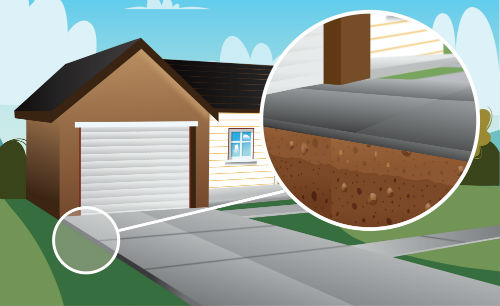
Mudjacking – After

Mudjacking – Before

Mudjacking – After

Mudjacking – Before

Mudjacking – Before


Mudjacking – Before
Mudjacking – Before

Mudjacking – After

Mudjacking – After


Mudjacking – After
Mudjacking – After
When concrete is leveled using mudjacking, the result is a longer-term fix that is more sustainable. It’s even possible that mudjacking could be less expensive than poly foam injecting, depending on the size of the affected area and who is doing the work.
When concrete is leveled using mudjacking, the result is a longer-term fix that is more sustainable. It’s even possible that mudjacking could be less expensive than poly foam injecting, depending on the size of the affected area and who is doing the work.
Have Concrete Raising Questions? We Have Answers!
Have Concrete Raising Questions? We Have Answers!
For a job as complex and precise as concrete leveling, you need an expert in your corner. AAA Concrete Raising is your go-to resource for concrete remediation, no matter how extensive the sagging or cracking is.
For a job as complex and precise as concrete leveling, you need an expert in your corner. AAA Concrete Raising is your go-to resource for concrete remediation, no matter how extensive the sagging or cracking is.
